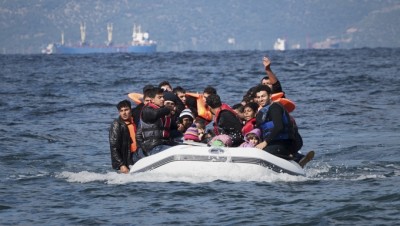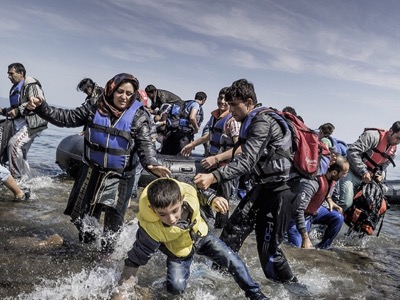How the European Union is Manipulating the Syrian Refugees

Triggered by the coordinated publication of the photograph of a young Kurdish child, Aylan Kurdi, drowned on a Turkish beach on the 3rd September 2015, European public opinion mobilised and mounted various demonstrations in favour of the refugees. Immediately, French President François Hollande and the chancellor of the German Federation Angela Merkel pronounced themselves favourable to a «permanent and obligatory European system of accomodation», while an immense crowd of people of mysterious origin began its progression across the Balkans. Only the Hungarian Prime Minister, Viktor Orban, spoke out against this sudden and massive migration.
The ESI proposal
Until then, the question of migration had been an economic problem, mainly between Africa and Italy. This was added to a problem internal to the Union – the demand of German heavy industry, expressed by its President Ulrich Grillo, of recruiting to Germany 800,000 East European workers who did not belong to the Schengen Area. Overnight, the problem of the humanitarian refugees fleeing a war zone was added to these two economic factors.
The first concrete proposition for responding to the new situation was formulated on the 17th September 2015 by the ESI, a think tank created in Berlin, and then clarified on the 4th October. It concerned the drawing up of an agreement between the EU and Turkey designed to stem the tide of migrants, while organising the transfer of 500,000 Syrian refugees to the Union over the next twelve months. In addition, Turkey would agree to take back the other migrants who continued to enter the Union illegally, while in exchange, it would receive a visa dispensation for all its citizens.

Arrival in Greece of Afghan migrants from Turkey
«It is a recognition that the Syrian crisis is genuinely unique, creating a humanitarian crisis on a scale not seen in Europe since the Second World War», indicated the ESI, specifying that the initiative should come from Germany, in response to the Russian intervention in Syria.
And yet,
- the ESI takes it as read that the Syrian refugees are fleeing «repression by Bachar’s régime» supported by Russia.
- the ESI only takes into account the Syrian refugees, and not the Iraqi refugees, who are also persecuted by Daesh.
the ESI specifies that its plan also has the objective
- of warning against the development of the extreme right in Austria – the director of this think-tank is Austrian ;
- of preparing a similar operation for 1.1 million Syrian refugees currently based in Lebanon, and who will be sent on to North America and Australia. This concerns the application of Kelly Greenhill’s theories about the «strategic management of migrations as a weapon of war» [1], such as that observed by ESI researchers during the start of the war in Kosovo [2].
In addition, by proposing to send back the migrants to Turkey, the ESI seems to ignore that this country is not a stable state for refugees, and that it had refused to sign the Convention of 1951.
The Merkel Plan
On the 23rd September, the European Council published a communiqué which, in turn, assimilated the question of the migrants to that of the war in / against Syria [3].
The main points of the ESI plan were resumed on the 7th October by Chancellor Angela Merkel, during an interview with journalist Anne Will on the TV channel ARD.
In order to present its project, now named the «Merkel Plan», the ESI organised conferences in Berlin, Ankara, Istanbul, Stockholm, Brussels and La Haye.
On the 12th November, independent of the emergency provoked by the hordes of migrants gathering in the Balkans, the Union organised a summit in Valetta to try to answer the structural question of economic migrations from Africa. It was agreed to create a special fund of 1.8 billion Euros for long-term projects which could offer a local economic perspective to Africans and help them to create stability at home.
On the 29th November, the Union organised another summit of the European Council, this time with Turkey. The «Merkel Plan» was adopted by both parties. However, an envelope of aid to Turkey was added, to the sum of 3 billion Euros.
The Council justified this sudden generosity as aid for the accommodation of the Syrian refugees who, until then, had cost Turkey 8 billion dollars – but there was no plan to pay an equivalent sum to Lebanon and Jordan, who together have hosted more Syrian refugees than Turkey. Yet the Council pretends to ignore that Turkish spending has already been reimbursed by the UNO, Qatar and Saudi Arabia, and that Turkey has systematically looted the North of Syria –dismantling machine-tools and stealing antique treasures– for infinitely greater sums. And finally, the majority of the 2.7 million Syrian refugees in Turkey have been integrated into the local economy, to the extent that less than 240,000 have been placed under the protection of the World Food Programme.
In reality, Germany and France, who pushed for the creation of this donation, intend in this way to indirectly finance the continuation of the war against Syria, which will – according to them – put an end to the suffering of the refugees by overthrowing the Syrian Arab Republic.
On the 21st January 2016, the director of the ESI, Gerald Knaus [4], published an op-ed piece in the Süddeutsche Zeitung. He defended the principle of a closer and more direct cooperation between Germany and Turkey, but without involving the EU. He concluded that a failure of the «Merkel Plan» would lead to «reinforcing those who wish to abolish the right to asylum, who are against the refugees, against the Union, against Turkey, against Muslims, and who support Putin. » [5].
Gerald Knaus does not explain how the fact of dealing directly between Berlin and Ankara without involving Brussels would help the struggle against Euro-scepticism. Neither does he explain why Russia would want to see Syrian refugees drowning in the Aegean.
No-one reacted to these insanities, since the refugee question has not been treated rationally for a long time.
The Merkel-Samsom Plan
On the 28th January, when the six-month rotating presidency of the European Council fell to Holland, Dutch Prime Minister Mak Rutte and his ally, the President of the Workers’ Party, Diederik Samsom [6], announced to De Volkskrant that they had prepared concrete measures for the implementation of the «Merkel Plan» [7]. As a result, one now speaks of the «Merkel-Samsom Plan» when talking about the project presented by the ESI [8].
In passing, we learn that Diederik Samsom has been consulting with several European Socialist governments since November, and that he has already visited Turkey.
On the 18th March, the European Council, presided by Holland, confirmed the implementation of the 29th November agreement [9]. Except that, by some miracle, the 3 billion Euros which were to be paid to Turkey had now become 3 billion annually.
And yet in the time between the two European summits, the number of refugees who entered the Union illegally, through Turkey via Greece, is estimated at about 200,000.
Observations on a deviation
In six and one half months, we have gone from a crisis concerning migrants who were mostly African, and who drowned in the Mediterranean before reaching the coasts of Italy, to a windfall for German heavy industry, which was able to hire 800,000 workers at minimal cost, and then to an operation for financing the war against Syria and the displacement of its population.
Indeed, it is recognised that
- On the 1st July 2015, the special representative of the UN General Secretary charged with international migrations, Peter Sutherland [10], forced the World Food Programme to diminish aid for Syrian refugees, making survival difficult for approximately 240,000 of those living in Turkey. In this way, the Anglo-Saxon pressure group that he represents intended to provoke a crisis which would harm the identity of the European nations. This decision, followed by the declarations of hospitality by the French President and the German Chancellor on the day following the publication of the photo of the corpse of young Aylan, led certain Syrian refugees to try for survival in Europe. Consequently, Peter Sutherland opposed the «Merkel-Samsom Plan», because it stabilises the populations, and uses the crisis against Syria alone.
- The Imprimerie Nationale Française, which until 2011 supplied Syrian passports, created a large number which, at the start of the crisis, were distributed to non-Syrian economic migrants – mainly Lebanese – thus increasing the pressure of « refugees» in Europe.
- The migration networks were organised not to bring Syrian refugees from Turkey to Europe, but to go and take Syrians from their homes in Syria and bring them to Europe. Rumours were spread which spoke of luxurious living conditions for Syrian refugees in Europe – a special airline was opened from Beirut, and a maritime line from Tripoli, to transport Syrians who were not refugees to Izmir. In the space of a few weeks, we saw middle-class citizens from Damascus and Latakia – who have always supported the Syrian Arab Republic – sell their businesses and take the road to exile.
Finally, and contrary to certain official declarations :
- The link between the pressure of migrants in Europe and the war in / against Syria is artificial. It has been deliberately created in order to provoke both the acceptance of the migrations and the indirect funding of the war by the Union. Although several hundred thousand Syrians have already been forced to cross the Mediterranean, it is unlikely that millions of others will follow.
- The mixture of populations that were organised to form the hordes of migrants who crossed the Balkans is particularly explosive. It includes Syrians and Iraqis, Afghans, Albanians and Kosovars etc. The fact that most of these people are Muslims should not obscure the fact that they have cultures and religious interpretations which are widely different – sociological origins and motivations which have no connection with one another.
- Apart from the episode of the second half of 2015, the migratory pressure on Europe remains essentially African. However, over the next few years, it could become Turkish. Indeed, should Ankara deprive 6 million of its citizens of their nationality, as it has announced, these people will do anything to flee their country of origin, if possible, before they become stateless. A transfer which could be facilitated by the abrogation of the visas necessary to Turkish citizens wishing to enter the Schengen Area.
Keep in mind :
- Three different group have manipulated the migrant crisis of the second half of 2015 :
- the partisans of the destruction of national cultures, around ex-President of the World Trade Organisation, Peter Sutherland, who believes that this was a way of favouring global free-exchange ;
- German heavy industry, around its President Ulrich Grillo, who hoped he would benefit from 800,000 new workers at minimal cost ;
- France and Germany, represented by François Hollande and Angela Merkel, who saw a way of legitimising the indirect funding of their war against Syria.
- These three groups have in common the fact that they support NATO, see each other on a regular basis, especially during the meetings of the Bilderberg Group, and share the same cynicism about populations. But their interests remain divergent, meaning that in the end, the states have won out over the partisans of global free-exchange.
- As is often the case in this sort of crisis, the populations deliberately set into motion have not exceeded a few hundred thousand people. They were added to other currents, older and more constant. It is the false media interpretation of the facts that give the impression of an imminent transfer of millions of people.
Translation
Pete Kimberley

